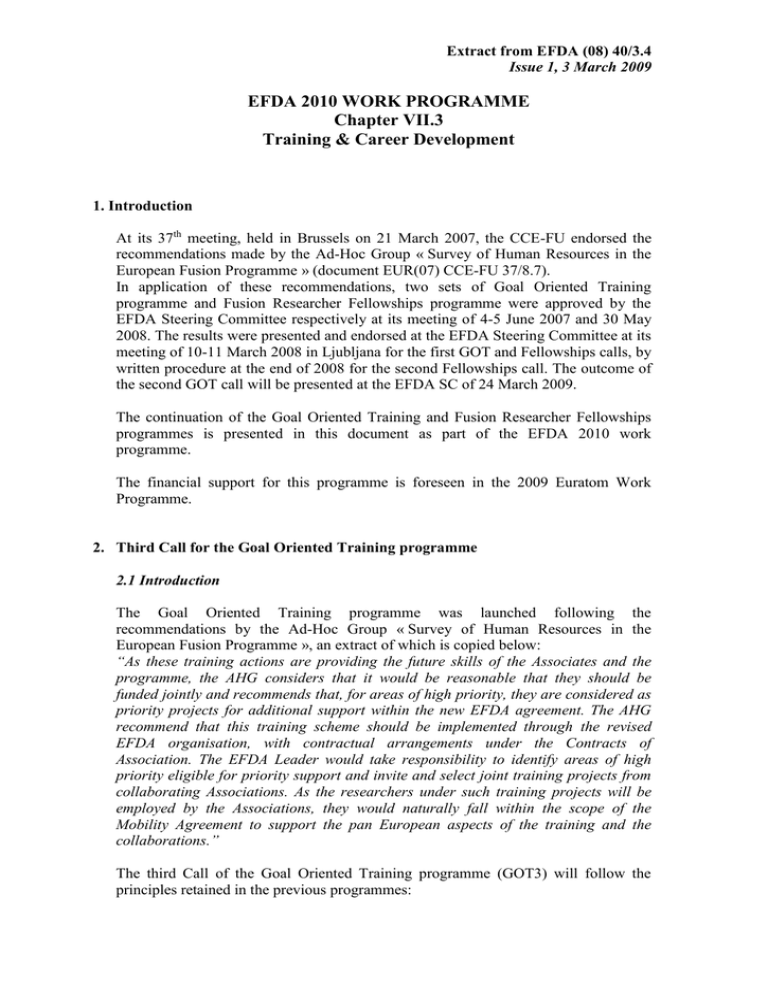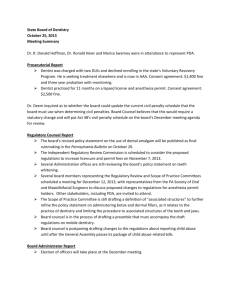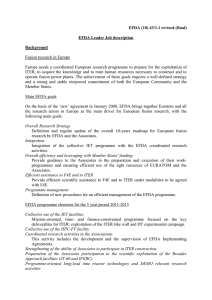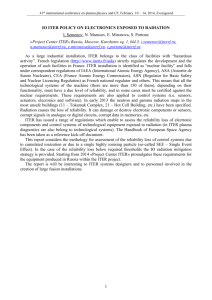EFDA 2010 WORK PROGRAMME Chapter VII.3 Training & Career Development
advertisement

Extract from EFDA (08) 40/3.4 Issue 1, 3 March 2009 EFDA 2010 WORK PROGRAMME Chapter VII.3 Training & Career Development 1. Introduction At its 37th meeting, held in Brussels on 21 March 2007, the CCE-FU endorsed the recommendations made by the Ad-Hoc Group « Survey of Human Resources in the European Fusion Programme » (document EUR(07) CCE-FU 37/8.7). In application of these recommendations, two sets of Goal Oriented Training programme and Fusion Researcher Fellowships programme were approved by the EFDA Steering Committee respectively at its meeting of 4-5 June 2007 and 30 May 2008. The results were presented and endorsed at the EFDA Steering Committee at its meeting of 10-11 March 2008 in Ljubljana for the first GOT and Fellowships calls, by written procedure at the end of 2008 for the second Fellowships call. The outcome of the second GOT call will be presented at the EFDA SC of 24 March 2009. The continuation of the Goal Oriented Training and Fusion Researcher Fellowships programmes is presented in this document as part of the EFDA 2010 work programme. The financial support for this programme is foreseen in the 2009 Euratom Work Programme. 2. Third Call for the Goal Oriented Training programme 2.1 Introduction The Goal Oriented Training programme was launched following the recommendations by the Ad-Hoc Group « Survey of Human Resources in the European Fusion Programme », an extract of which is copied below: “As these training actions are providing the future skills of the Associates and the programme, the AHG considers that it would be reasonable that they should be funded jointly and recommends that, for areas of high priority, they are considered as priority projects for additional support within the new EFDA agreement. The AHG recommend that this training scheme should be implemented through the revised EFDA organisation, with contractual arrangements under the Contracts of Association. The EFDA Leader would take responsibility to identify areas of high priority eligible for priority support and invite and select joint training projects from collaborating Associations. As the researchers under such training projects will be employed by the Associations, they would naturally fall within the scope of the Mobility Agreement to support the pan European aspects of the training and the collaborations.” The third Call of the Goal Oriented Training programme (GOT3) will follow the principles retained in the previous programmes: Extract from EFDA (08) 40/3.4 Issue 1, 3 March 2009 - - In particular and as agreed at the EFDA Steering Committee in Ljubljana (1011 March 2008) the programme will target trainings toward priority areas (see proposal under section 2.2 below). Lessons learned from the second Call which has been widely under-subscribed by the Associations will be taken into account. To that matter the questionnaire launched mid November 2008 has been very informative. The answers to this questionnaire as well as proposals for changes will be presented at the EFDA SC of 24 March 2009. The scheme is proposed to be reinforced as presented under section 2.3 below. 2.2 Priority areas For this GOT3, priority areas have been discussed within EFDA and with Fusion for Energy (F4E). This analysis has been conducted on the basis of ongoing programmes EFTS, GOT1 and GOT2, as summarised in Annex 1. This Annex also summarises the needs identified in the assessment conducted together with F4E; most of the priority areas proposed are meant to satisfy training needs identified by F4E in relation to ITER. The following list of priority areas with targets for the number of trainees is proposed for GOT3: - Materials: 5-7 trainees (or equivalent ppy/year) - Engineering (large components): about 3 trainees (or equivalent ppy/year) - Remote Handling: 8-12 trainees (or equivalent ppy/year) - Be Technology (plasma facing components): 3-4 trainees (or equivalent ppy/year) - Vacuum Technologies and Pumping: 3-5 trainees (or equivalent ppy/year) - Cryo Technologies: 3-5 trainees (or equivalent ppy/year) - Diagnostic Techniques (project engineers and engineering in extreme environment): 6-8 trainees (or equivalent ppy/year) Detailed objectives for each priority area are given in Annexes 2 to 8. 2.3 Implementation scheme As a result of the second Call, the questionnaire sent to Associations and the analysis made by EFDA, and as an outcome of discussions with the evaluators of GOT2, an evolution the training scheme is proposed below. As in previous years: - All proposals have to be cooperative projects involving at least 3 EFDA Associates. - Only projects addressing one of the above mentioned priority areas will be accepted. - It is expected that training will mainly be proposed for new staff specifically recruited. - Several projects could address the same topic. The main criterion for the selection of projects will be excellence. Projects failing to reach an appropriate level of quality will be rejected. As a consequence, it may happen that not all Extract from EFDA (08) 40/3.4 Issue 1, 3 March 2009 priority areas are addressed in the programme or that two or more projects are accepted within one priority area. In addition, the following features are proposed to be requested from each training project: - each trainee must have a well defined project. - the programme of each trainee shall include QA & RAMI, possibly as transverse activities: in particular the QA programme (foreseen to be launched under GOT2) should be made available to all trainees for all projects. - reporting is considered as an important function in the education of the trainee. Therefore, and in addition to a yearly written report to EFDA, trainees should address twice a year personal reports to their supervisors or maintain a logbook. They should make one oral presentation per year, including, over the 3 year training period, at least one presentation to an international conference or workshop, or, if not feasible, a presentation in a specific seminar in another Association. - to ensure the training provides the right expertise, close contacts with F4E (who organise procurement for ITER) and ITER are recommended in all appropriate cases. It is in fact recommended that F4E is invited to be involved in the steering body of the projects in all cases where the training relates to ITER technologies. Furthermore the EFDA-CSU Garching will implement the following facilitating measures: - To facilitate the formation of clusters, EFDA will launch a call for interest preliminary to the call for proposals, so that Associations can express their readiness to take the leadership of a programme and contacts could be anticipated to form clusters. - EFDA will set-up a trainee website for sharing tutorials of general interest and with links to FUSENET and other training programmes. - EFDA will organise a feed-back process (in particular from the trainees). 2.4 Provisional timetable for GOT3 The following time table is presently foreseen: - early May 2009: call for interest to facilitate the formation of clusters - late June 2009: Call for GOT3 - October 2009: deadline for answering the Call - November 2009 to January 2010: assessment by EFDA and proposal for implementation to the EFDA SC. 3. 2009 Fusion Researcher Fellowships Before the end 2009, EFDA will launch a third Call for “Fusion Researcher Fellowships” proposals. In line with the recommendations by the Ad-Hoc Group « Survey of Human Resources in the European Fusion Programme », the answers to the Call shall be channelled through the Heads of Associations, all fusion researchers having a post-doctoral contracts starting between 1 January and 31 December 2009 will be eligible and the fellowships will be “awarded according to the sole exceptional quality of the candidates and his/her proposal”. Extract from EFDA (08) 40/3.4 Issue 1, 3 March 2009 The duration of the Fellowships supported by this action will be up to two years. 4. Resources The Community participation in the financing of these training actions will be up to 5 and 1.3 million euro for the Goal Oriented Training and the Fusion Researcher Fellowships respectively, at the support rates specified in the 2009 Euratom Work Programme. This should provide funding for: - up to 40 trainees (ppy/year) over three years for the third call of the Goal Oriented Training programme, and - up to 10 Fusion Researcher Fellowships grants. The Community funding of the training projects will be provided under Article 8.2e of the Contract of Association. Extract from EFDA (08) 40/3.4 Issue 1, 3 March 2009 Annex 1 Results of the previous calls (EFTS, GOT1 and GOT2) and analyse of the needs in the further training programmes STATUS TOPIC Ongoing or foreseen Training Programme MATEFU (EFTS) W7X SC (EFTS) none Year of start BREEDING BLANKETS TRITIUM TECHNOLOGIES ENGINEERING EUROBREED (GOT1) 2008 8/288 FUEL CYCLE (EFTS) TRI TOFFY (GOT1) ITER PPE (GOT1) 2007 2008 2008 5/180 6/216 8/216 REMOTE HANDLING PFCs PREFIT (EFTS) 2007 6/216 ETN PFM (EFTS) 2007 6/252 VACCUM TECHNOLOGIES AND PUMPING None MAGNETS MATERIALS 2007 2007 Number of trainees/ppm 8/288 4/144 PROPOSAL Recommendation for future programmes No further need identified at present High Priority. 15-20 to be trained in batches over 3 years 5-7/year Sufficient on the short term / to be reassessed one year before end of ongoing programme Sufficient on the short term / to be reassessed one year before end of ongoing programme High Priority: launch a programme on large component engineering about 3 trainees. Content of ITER-PPE will be analysed by F4E to assess if further training action is needed. High Priority: 20-30 to be trained in batches over 3 years, about 10/year High Priority: 3-4 to be trained, with emphasis on Be PFCs High Priority: 3-5 to be trained Extract from EFDA (08) 40/3.4 Issue 1, 3 March 2009 CRYOTECHNOLOGIES POWER SUPPLIES None PSE (GOT2 under assessment) (2009 TBC) 5/180 (TBC) QA ETN-QPM (GOT2 under assessment) (2009 TBC) 5/144 (TBC) OPERATION TOP (GOT2 under assessment) (2009 TBC) 5/162(TBC) NB NIPEE (GOT1) NIPEE2 (GOT2 under assessment) 2008 (2009 TBC) 3/120 5/180 (TBC) ICRH EnTICE (EFTS) LITE (GOT1) 2007 2008 6/204 7/252 ECRH DIAGNOSTICS EC-TECH (EFTS) EODI (EFTS) MDEI (EFTS) RAOC (GOT1) GOTiT (GOT1) 2007 2007 2007 2008 2008 6/192 8/264 4/88 1/36 16/156 MODELLING High Priority: 3-5 to be trained Overall needs presently identified: - 2009: 32-42 plus possible beefing-up QA and TOP - 2010: 20-25 plus other possible needs according to the outcome of on-going programmes - 2011: 15-17 plus other possible needs according to the outcome of on-going programmes No further need identified at present if PSE is good and launched Disappointing that so few Associations are involved / proposal will be assessed by FE4 and EFDA. It might be required to beef-up the proposal and present a revised proposal before July EFDA SC Proposal will be assessed by FE4 and EFDA. It might be required to beef-up the proposal and present a revised proposal before July EFDA SC Sufficient on the short term if NIPEE2 is launched / to be reassessed one year before end of ongoing programme No further need identified at present / to be reassessed one year before end of ongoing programme to be reassessed next year High Priority: 10-15 project engineers and engineering in extreme environment to be trained. Two batches of 5-8 each. No further need identified at present Extract from EFDA (08) 40/3.4 Issue 1, 3 March 2009 Annex 2 Third Call of the Goal Oriented Training Programme Priority Area Materials Science and Technology Objective The aim of this training is to provide knowledge and to develop expertise of young engineers to fulfil future duties in the various fields of science and technology of structural materials foreseen for in-vessel components in DEMO and TBM The materials that are of interest to DEMO, together with the required engineering techniques, are still under development. These materials include the low activation ferritic/martensitic steel EUROFER (foreseen to be used on the ITER TBM), nanostructured low activation Fe-Cr steels and tungsten alloys as structural, heat sink or protective elements. Thus training is needed in the procurement of these materials, managing qualification programs and guiding the development of the materials. To achieve this, it is foreseen that the training includes practical and/or theoretical laboratory activities and educational tasks (formal courses and conferences). Training Activities The training will require the involvement of senior engineers and scientists in material science and materials engineering with proven experience in the topics of the training. (A) The main activities should include: Specific issues of structural materials in fusion, e.g.: Selection of materials, alloy compositions and tailoring of properties (activation) Properties and failure mechanism under radiation (hardening, fracture, creep) and the role of gaseous transmutations, especially helium. (B) Modern tools for modelling and simulation of radiation e.g.: Methods to simulate evaluation of micro-structure (e.g. DFT calculations, kinetic Monte Carlo, Rate Theory, Molecular Dynamics, Discrete Dislocation Dynamics) Advanced characterization methods including electron microscopy (SEM and/or TEM), Energy Dispersive Spectroscopy (EDS), diffraction methods (XRays, neutrons), Atom-Probe tomography (APT), and micro-mechanical testing. (C) Practice in materials technology, e.g.: Overview on different fabrication processes and joining techniques (TIG, electron beam, laser, diffusion bonding, HIP, property gradient joints, brazing) Qualification of base materials and welds according to (nuclear) standards Non-destructive testing. Part of the trainees should have an engineering background and develop knowledge during the training towards material technologies. Other trainees should have a Extract from EFDA (08) 40/3.4 Issue 1, 3 March 2009 material physicist background and develop knowledge during the training towards fusion material sciences and modelling. A dedicated effort will have to be made to give materials engineers the best of the knowledge concerning modern simulation tools involved in multi-scale modelling, their present capabilities and limits. In addition, specific courses should be given on the management and follow-up of technical contracts as well as on QA. Extract from EFDA (08) 40/3.4 Issue 1, 3 March 2009 Annex 3 Third Call of the Goal Oriented Training Programme Priority Area Engineering of large components Objectives of the training: The objective of this training is to prepare young engineers for the procurement, construction and assembly of the main components of the ITER load assembly. The construction of the main, large components of ITER, such as magnets and vacuum vessel requires deep knowledge and competence in numerous fields of engineering: mechanical design, material, thermal, hydraulics, mechanics, electromagnetic, neutron physics, numerical simulation, manufacturing technologies, project management, procurement management, nuclear engineering, quality assurance in nuclear projects. The challenge for young engineers will be to apply, reinforce and combine their skills to the specific and unusual operation conditions of ITER, to apply these customized competencies during the next phases of fusion projects and especially for any future development in the procurement of ITER components. Contents of the training The aim of the training is to reinforce the knowledge of the trainee by involvement in engineering teams (in Associations and Companies), constituted of experts in various domains in the following activities: Mechanical design Electro magnetic physics applied to superconducting magnets Vacuum technologies in nuclear environment Thermal analysis and basis on cryogenics Applied material science Product data management Configuration and interface management Project management Procurement management with a focus on suppliers risk assessment Technical specification Management specification Contracting Manufacturing follow-up issues with industrial suppliers In addition, an introduction should be effected by formal courses and practical experience in design tools (especially Catia V5, ANSYS), the ITER design (Magnets, Vacuum vessel, Assembly, ), Quality Assurance in nuclear engineering, nuclear code and standards (RCC-MR, RCC-MX, ASME...) and neutronics and radiation protection. Extract from EFDA (08) 40/3.4 Issue 1, 3 March 2009 Annex 4 Third Call of the Goal Oriented Training Programme Priority Area Remote Handling for Fusion Reactors Objective The aim of this training is to prepare engineers for activities to support the ITER project and the long-term fusion programme in European Associations, Associates, Fusion for Energy and in the ITER Organization and Industry. In the specific case of this training, the objective is to provide a combination of background information and theoretical basis, perform laboratory experience, and exercise on project-oriented tasks; this is in order to develop in the trainees expertise in the various fields of ITER Remote Maintenance. Training Activities The main activities to be included in the training are one or more of the following: Fundamentals of Remote Maintenance for Fusion Reactors Robotics and machine automation in a nuclear environment Hot cell-like operations Tooling for remote handling tasks on piping, bolts, connectors Remote sensing techniques Virtual reality Control systems Radiation hardness of materials, sensors, components ITER-relevant software products (e.g. DELMIA, ITER Web based code of practices for remote handling engineering). In addition, stages in laboratories, industries and institutions, with laboratory activities shall complement the formation of the trainees. The training programme will include also a project-oriented task for each participant, in order to put into a relevant context the know-how and experience gained. Specific courses should be given on the management and follow-up of technical contracts, including inter alia scheduling and monitoring of activities, as well as on QA, the basis for any kind of work and procurement. Extract from EFDA (08) 40/3.4 Issue 1, 3 March 2009 Annex 5 Third Call of the Goal Oriented Training Programme Priority Area Beryllium Technology (plasma facing components) Objective The objective of the training is to give the candidates the basic knowledge and experience needed to fulfil future duties for the procurement of the ITER First Wall. In the case of the ITER First Wall, the armour material is Beryllium. Beryllium has properties that make it necessary for engineers working with it to take specific training and to gain experience in its use. Training Activities The training will require the involvement of experienced senior engineers from JET with proven experience in the topics of the training. The main activities to be included in the training are: Theoretical courses on Beryllium properties and main applications, Current understanding of Beryllium hazards and overview of health and safety regulations applied for Beryllium, Applications to fusion activities including for example: o First Wall fabrication routes and joining techniques, o Design of Beryllium facilities including e.g. containment, ventilation requirements, o Requirements for protective equipments and health surveillance procedures, o Waste management including e.g. storage, decontamination and disposal requirements. Participation to the production and the assembly of the ITER-like First Wall of JET. In addition, stages in laboratories, industries or institutions could complement the formation of the trainees. Extract from EFDA (08) 40/3.4 Issue 1, 3 March 2009 Annex 6 Third Call of the Goal Oriented Training Programme Priority Area Vacuum Technologies and Pumping Objective The aim of this training is to train a number of new engineers with expertise in the design, specification and procurement activities in the ITER vacuum pumping systems, as described in the following. The European procurement for ITER in the area of Vacuum technologies and pumping systems covers activities for the supply of cryopumps for Torus, Cryostat, Heating and Diagnostics Neutral Beam systems, cold valve boxes, instrumentation and the R&D needed to finalise the design of these components. Of particular note and importance in respect of the ITER vacuum systems is their relatively large scale. Training Activities The areas of expertise that are required are the following: Cryogenics engineering Instrumentation/vacuum engineering Leak detection/localization/vacuum engineering Mechanical engineering Physics: experimental measurements and modelling of gas conductance in ducts. The main activities to be included in the training are: participation in the design, R&D and procurement activities in the Associates under supervision by senior engineers; participation in specialised courses in the areas of expertise above; specific training and courses in QA procedures and on the management and follow-up of technical contracts; and training and courses in planning, including the use of related software such Primavera. The training will combine theoretical lessons, practical laboratory experience and project-oriented tasks in the area of vacuum pumping systems in order to develop the experience necessary for the procurement of vacuum and pumping systems. In addition, stages in laboratories, industries or institutions could complement the formation of the trainees. Extract from EFDA (08) 40/3.4 Issue 1, 3 March 2009 Annex 7 Third Call of the Goal Oriented Training Programme Priority Area Cryoplant systems Objective The objective is to train a number of new engineers with expertise in the R&D, design, specification, procurement activities, installation and commissioning follow up in the ITER cryoplant system. This training will combine theoretical lessons, practical laboratory experience and project-oriented tasks in the area of cryoplant and cryogenic systems in order to allow Fusion for Energy, the Associates and ITER to have experienced persons to work on the design and construction of the ITER cryoplant systems. Training Activities The European procurement for ITER in the area of Cryoplant systems covers activities for the R&D, design, procurement, installation and commissioning for the LHe plants, LN2 plants, 80K loop, helium and gas management systems of the ITER cryoplant system. The areas of expertise that are required are the followings: Fluid dynamics and numerical calculations; Cryogenic engineering; Instrumentation and control systems; Mechanical engineering; and Plant design engineering. The main activities to be included in the training are: participation in the R&D, design and procurement activities in the Associates under supervision by senior engineers; participation in specialised courses required for the areas of expertise listed above; specific training and courses in QA procedures and on the management and follow-up of technical contracts; and training and courses in planning, including the use of related software such Primavera. In addition, stages in laboratories, industries or institutions could complement the formation of the trainees. Extract from EFDA (08) 40/3.4 Issue 1, 3 March 2009 Annex 8 Third Call of the Goal Oriented Training Programme Priority Area Diagnostic engineering for extreme environments Objective: The development of diagnostic components for ITER and future fusion reactors is very challenging due to the extreme nature of the ITER environment, with nuclear; thermal; electromagnetic; and particle loads in high vacuum and electrically noisy conditions. Diagnostic engineering on present machines only prepares for a small subset of these challenges. The objective of this training is to develop project engineers with a broad spectrum of knowledge, spanning the whole range of engineering issues required for the design of diagnostic systems for ITER. Training Activities: Overview of plasma diagnostics (optical, microwave, spectroscopic, fusionproduct, magnetics, other), diagnostic needs (electrical, calibration, alignment, positioning) and engineering aspects; Engineering in a nuclear environment (legal aspects, licensing, applicable codes and standards, ALARA, occupational radiation exposure); Electromagnetic loads in a tokamak; Thermal loads (radiation, nuclear); Cooling circuits and thermo-hydraulic analysis; Vacuum (vacuum systems, materials, tritium/safety, beryllium, electrical and mechanical feedthroughs, movement in vacuum, windows, outgassing); Neutronics analysis (codes, streaming, heating, activation); Nuclear effects in structural materials, welds, functional materials (e.g. transmission and insulating materials) and diagnostic components; Vibration effects; Particle loads (chemical and physical sputtering, erosion, deposition); Metrology for accurate positioning; Remote handling (handling, tooling, electrical connectors); and Electromagnetic and other noise (shielding, cables, connectors) The emphasis will be on gaining understanding, but should include training on the use of specific analysis software in some of the areas listed above. The trainees will consolidate the training by stages with diagnostic groups in the Associates that are doing work on ITER. Stages in laboratories, industries or institutions could complement the formation of the trainees (e.g. Nuclear or Space industries/institutions). In addition, it is foreseen that trainees are given courses in “transverse” subjects, such as QA, project management, industrial follow-up and RAMI.



